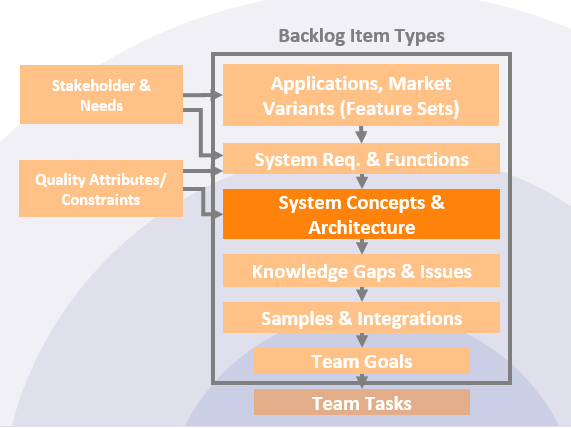System concepts describe possible solutions for system and product variants (applications = feature sets) and their requirements . System concepts implement the System Requirements within the restrictions (contraints) and balance the quality requirements (Quality Attributes)out. The P4 framework explicitly provides several System Concepts as solution options for the implementation of System Requirements in the system backlog. This means that several solutions to a problem may be identified and developed further (divergence in the solution space). The goal of product development is to only develop so many different System Concepts (in parallel or in succession) until some concepts are disqualified and ideally a clear favorite emerges. Depending on the degree of innovation in the development, this can be a very large number of concepts at first, or new concepts may even arise during product development.
System Architecture
The static part of System Architectures describes the allocation of Functions and Capabilities to subsystems and Modules of the system, and their interfaces. This is done e.g. by using the block diagrams from the SysML. The dynamic part describes the behavior of the subsystems and modules, e.g. using sequence diagrams, activity diagrams, diagrams of state machines of the SysML.
The descriptive documents of the system (the specifications, user handbooks, …) are also often treated as “components” or deliverable objects. This ensures that the documentation grows synchronously with the functional scope and maturity of the system.
Evaluation and selection of System Concepts
For the selection of System Concepts and alternative solutions, the P4 framework can use methods of classical systems engineering, such as …
- Morphological box
- Pugh matrix (weighted evaluation table)
- Decision table with evaluation categories (++/+/0/-/–)
- Balanced design graphs
- Trade-off analyses
Methods from the Design for Six Sigma (DFSS) methodology toolbox can also be used to evaluate and select system concepts:
- Design scorecard
- Poka Yoke
- QFD for design
- Effect chain analysis
- Design of Experiments (DoE)
Platform concepts
In today’s product development, the concept of reuse and thinking in building blocks, product lines and platforms has become very popular. This is reflected in the P4 framework by the architectural aspect of this level. The requirements for the platform are contained in the ” Quality Attributes & Constraints ” (e.g. modularity, reusability, markets and applications).
The responsibility for the platforms, their modules and interfaces have the Module- and Platform Teams or Platfrom Cluster for bigger platforms.
Capabilities
The responsibility of the Cluster System Engineer is also the assignment of so-called capabilities to Modules, which are described as services in more complex systems. The basic idea is that certain Modules provide services that can be used by other Modules.
Further suitable links:
| Events | Roles | Groups | Artifacts |
| Cluster Planning | .
. |
Team Product Owner Group
. |
Inspectable Results
. Usable Knowledge & System Increment . |
